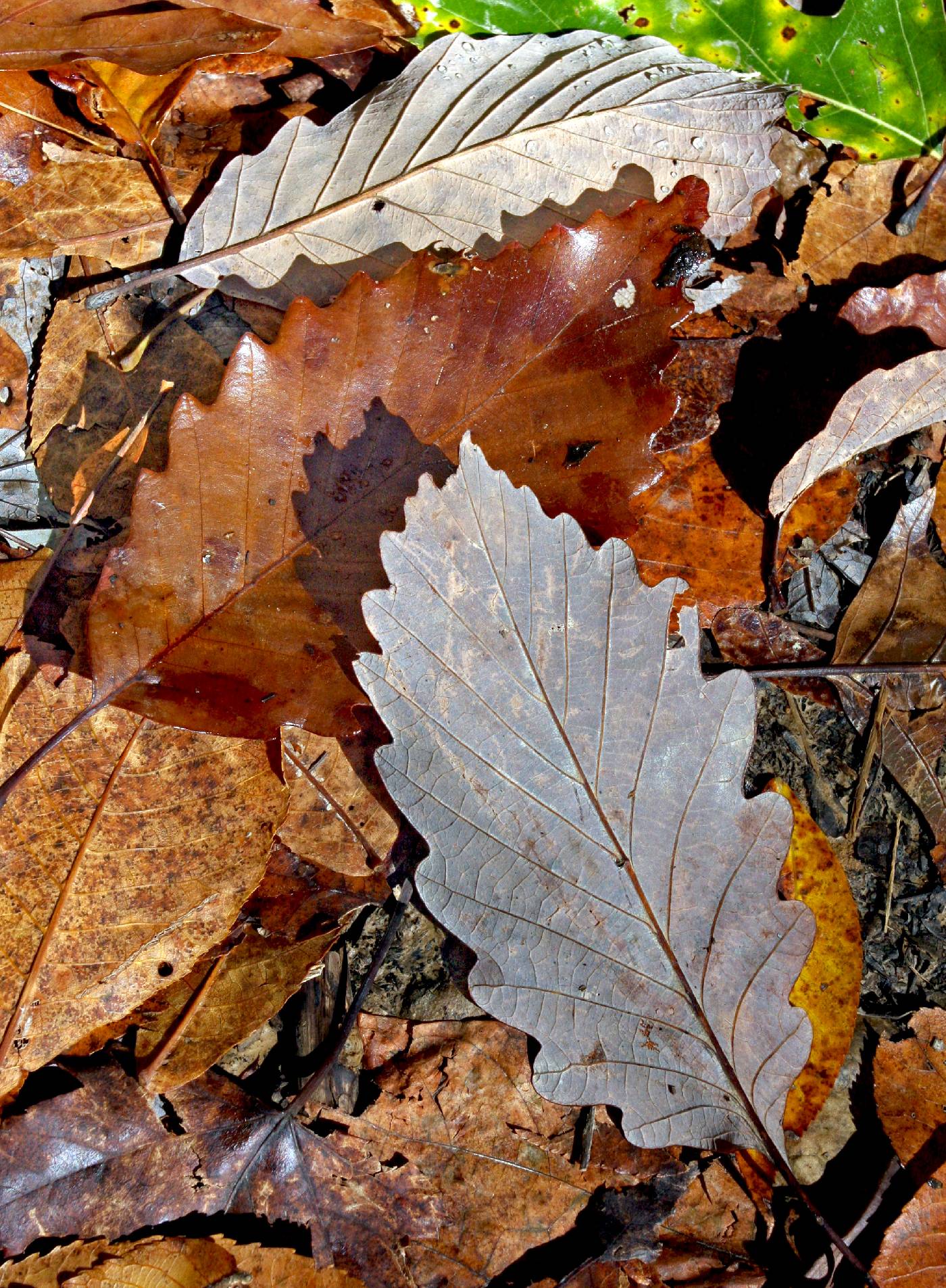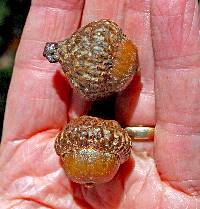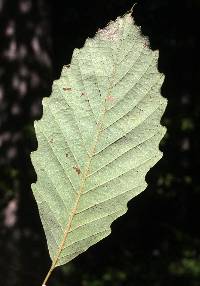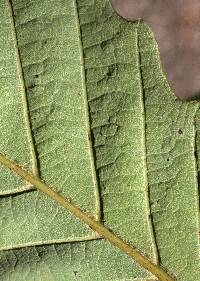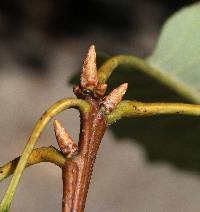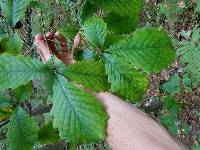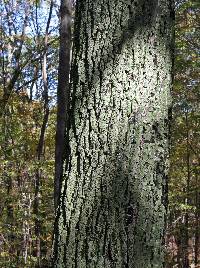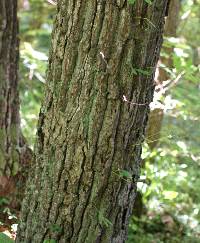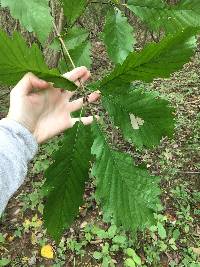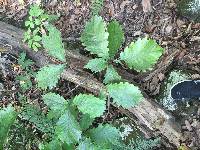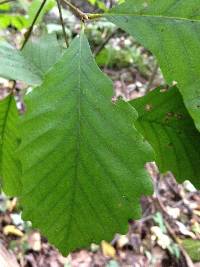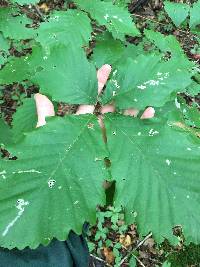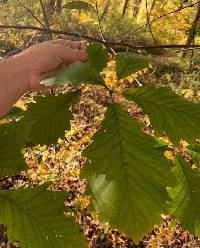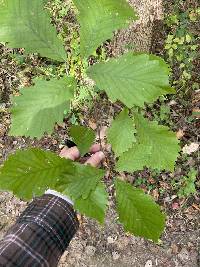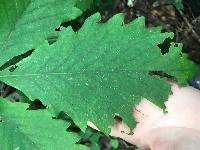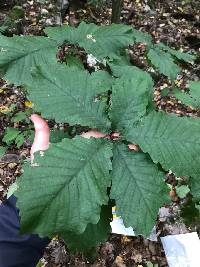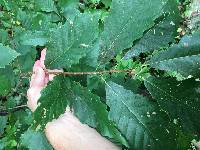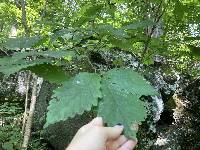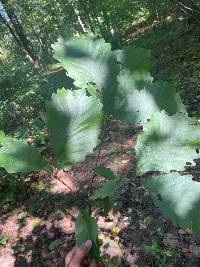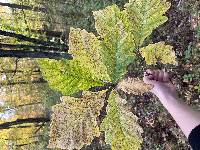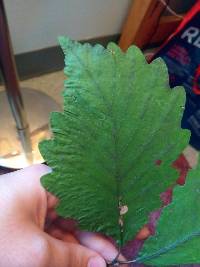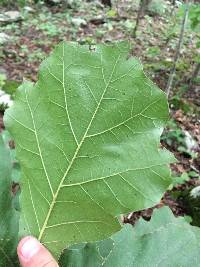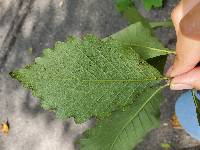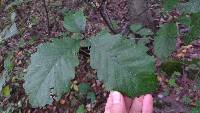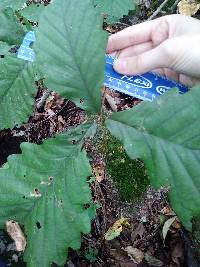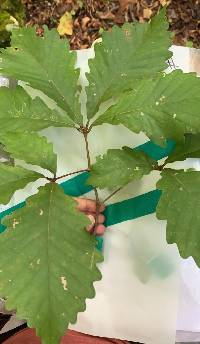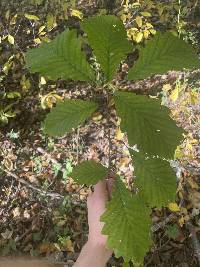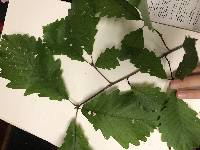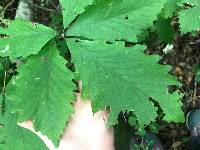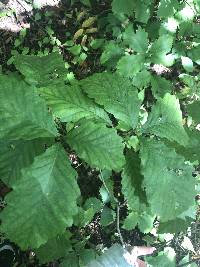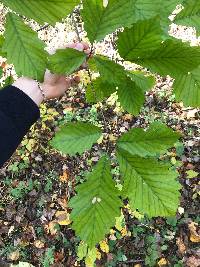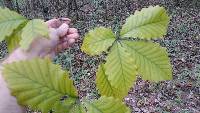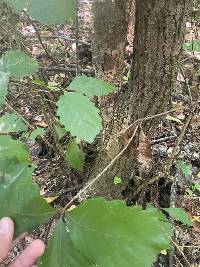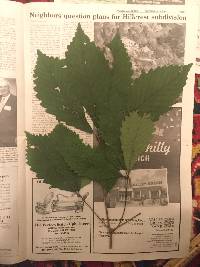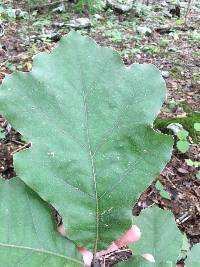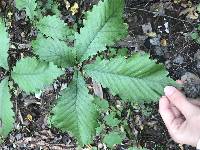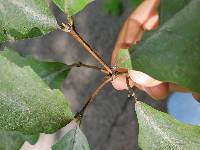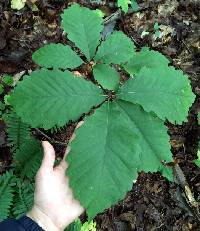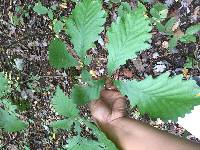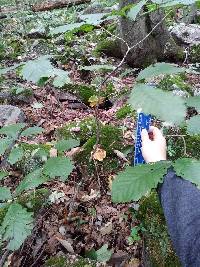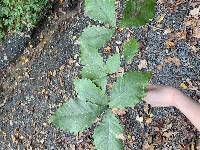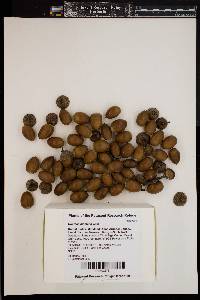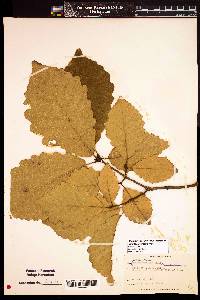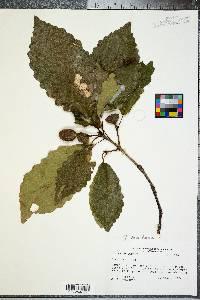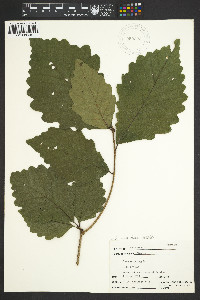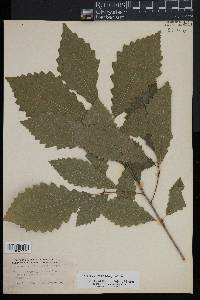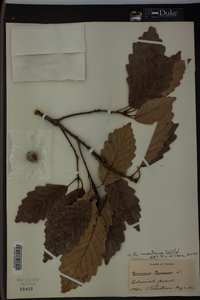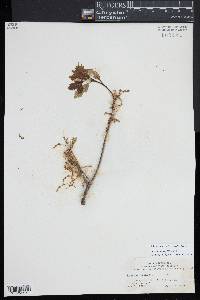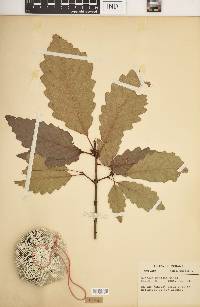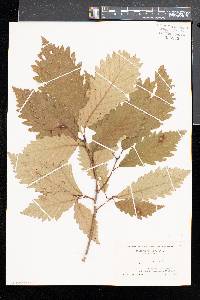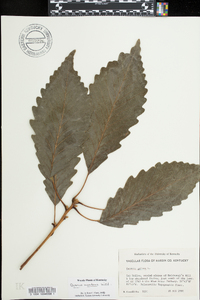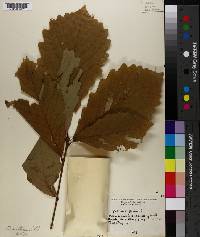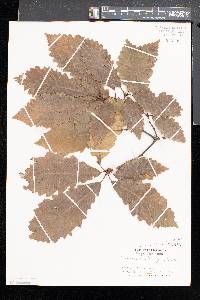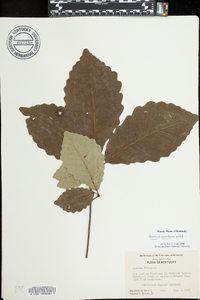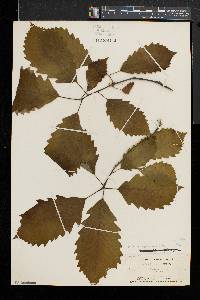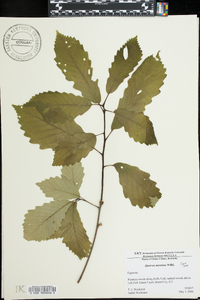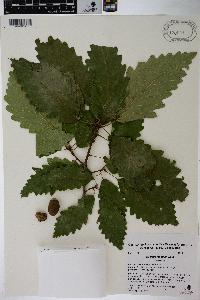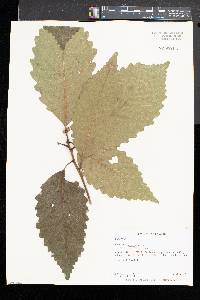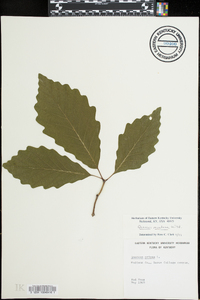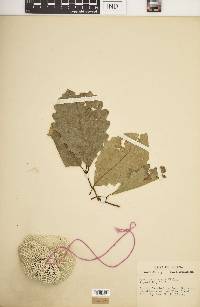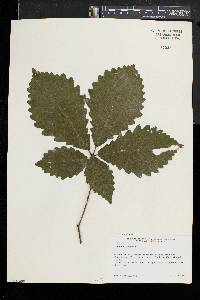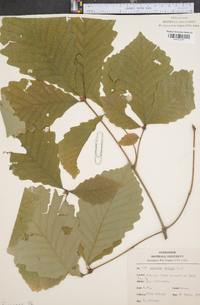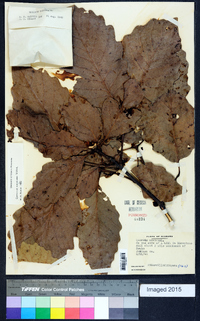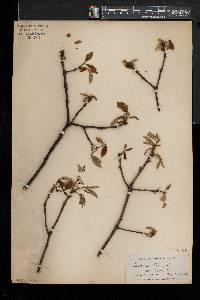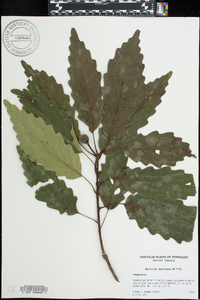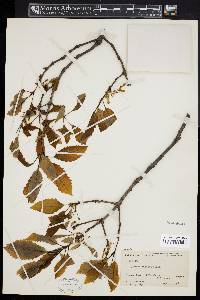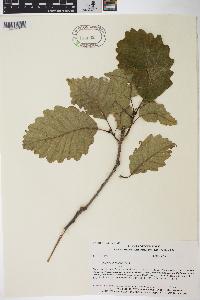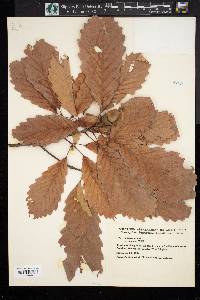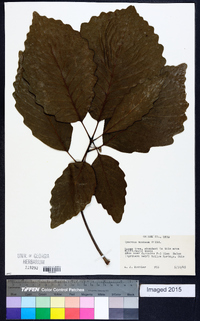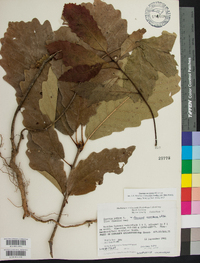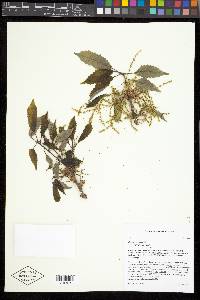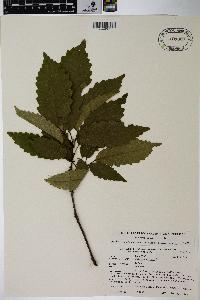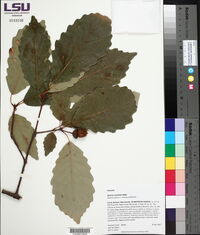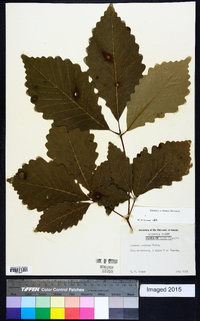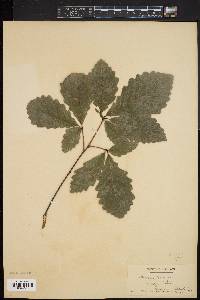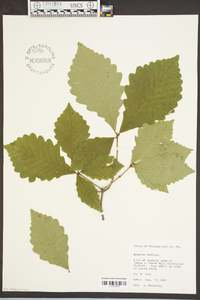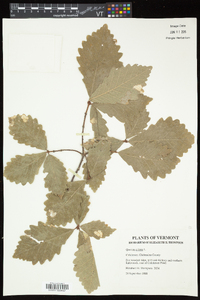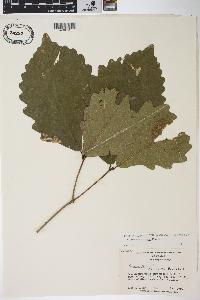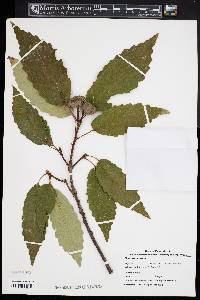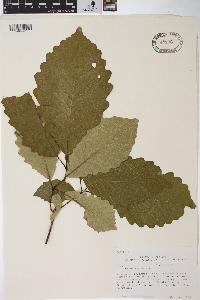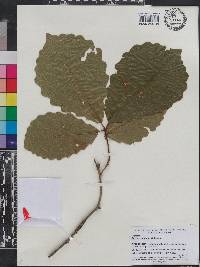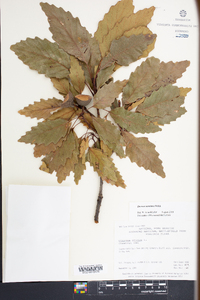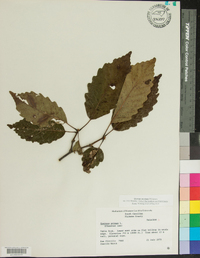
|
|
|
|
Family: Fagaceae
Chestnut Oak
[Quercus prinus var. monticola Michx., moreQuercus versicolor Raf.] |
Trees , deciduous, to 30 m. Bark dark gray or brown, hard, with deep V-shaped furrows. Twigs light brown, 2-3(-4) mm diam., glabrous. Buds light brown, ovoid, (3-)4-6 mm, occasionally apex acute, glabrous. Leaves: petiole (3-)10-30 mm. Leaf blade obovate to narrowly elliptic or narrowly obovate, (100-)120-200(-220) × 60-100(-120) mm, base subacute or rounded-acuminate, often unequal, margins regularly toothed, teeth rounded or rarely somewhat acute, secondary veins ± parallel, straight or moderately curved, 10-14(-16) on each side, apex broadly acuminate; surfaces abaxially light green, appearing glabrous but with scattered minute, asymmetric, appressed-stellate hairs and usually visible, larger, simple or fascicled erect hairs along veins, adaxially dark green, glossy, glabrous or with minute, scattered, simple hairs. Acorns 1-3, subsessile or on peduncle 8-20(-25) mm; cup shallowly cup-shaped to hemispheric or deeply goblet-shaped, rim thin, often flared and undulate, helmetlike, 9-15 mm deep × 18-25 mm wide, scales often in concentric or transverse rows, laterally connate, gray, broadly ovate, tips reddish, glabrous; nut light brown, ovoid-ellipsoid, 15-30 × 10-20(-25) mm, glabrous. Cotyledons distinct. 2 n = 24. Flowering mid-late spring. Rocky upland forest, dry ridges, mixed deciduous forests on shallow soils; 0-1400 m; Ala., Conn., Del., Ga., Ill., Ind., Ky., Maine, Md., Mass., Mich., Miss., N.H., N.J., N.Y., N.C., Ohio, Pa., R.I., S.C., Tenn., Vt., Va., W.Va. The name Quercus prinus Linnaeus is often applied to this species, particularly in the forestry literature, and in many regional floras. In a number of works, however, Q . prinus has been applied to the species here treated as Q . michauxii . Following the recommendations of J. W. Hardin (1979), because of the persistent confusion in the application of the name Q . prinus and uncertainty regarding the identity of the Linnean type materials, the names Q . montana and Q . michauxii should be used for the two species that have been variously called Q . prinus . Quercus prinus under this interpretation is a name of uncertain position. The four species of the chestnut oak group in eastern North America ( Quercus montana , Q . michauxii , Q . muhlenbergii , and Q . prinoides ) are somewhat difficult to distinguish unless careful attention is paid to features of leaf vestiture and fruit and cup morphology. Attempts to identify these species mostly or solely on basis of leaf shape and dentition (as in many other oak species complexes) have resulted in a plethora of misidentified material in herbaria and erroneous reports in the literature. The closely appressed, asymmetric trichomes on the abaxial surface of the mature leaf, in combination with longer simple hairs along the midvein, are unique to Q . montana among North American species of Quercus . Immature leaves and densely shaded leaves sometimes exhibit a more erect trichome that could be confused with the longer, felty hairs of Q . michauxii , so it is important to evaluate mature sun leaves when possible.
Tree 15 - 30 m tall, trunk 0.6 - 1.3 m in diameter Leaves: alternate, stalked, shiny yellowish green above, paler with soft hairs beneath, 10 - 25 cm long, 3.6 - 7.5 cm wide, inversely egg-shaped with a tapered base, coarsely to round-toothed. Leaves turn orangish yellow to yellowish brown in fall. Flowers: either male or female, found on the same tree (monoecious), yellow male flowers borne on hanging catkins 5 - 8 cm long, female flowers solitary or in groups of two to four near leaf axils. Fruit: an acorn, solitary or in pairs. A deep bowl- or top-shaped cup covers one-third to half of the nut and has reddish brown, thick, rough, and hairy scales. Nut shiny light brown, 2.5 - 3.8 cm long, 1.5 - 2.5 cm in diameter. Bark: deep reddish brown and fairly smooth, becoming nearly black and fissured or furrowed. Twigs: purplish green, turning orangish brown during the first winter and dark gray in the second season. Buds: shiny dark brown, 4 - 6 mm long, pointed. Each terminal bud is surrounded by a cluster of lateral buds. Form: broad, open, irregular. Similar species: Castanea dentata, Quercus muhlenbergii and Quercus montana have similar leaves. Castanea dentata leaves have sharply toothed margins with a vein extending into a bristle at the tip of each tooth, and the nuts are enclosed in a sharp, prickly bur that splits on four sides. The teeth of Q. muhlenbergii leaves are somewhat sharply pointed but do not have extended bristles, the acorns have slightly hairy cups covering one-quarter to half of the nut, and the bark is silvery gray and flaking with narrow scales. Flowering: April to May Habitat and ecology: Sandy, gravelly, or dry hillsides and ridges to areas with rich, well-drained soils. Occurence in the Chicago region: non-native Notes: The bark of Q. montana was once used for tanning leather due to its high tannin content. Lumber from the tree is sold as white oak. Quercus montana naturally hybridizes with Q. alba (Q. x saulei). Etymology: Quercus is the Latin name for oak. Montana is derived from the Latin word meaning "of the mountains."The common name chestnut oak comes from the leaves resemblance to those of a chestnut, Castanea sp. Author: The Morton Arboretum From Flora of Indiana (1940) by Charles C. Deam In Indiana this species is restricted to the area indicated on the map where it is found on the ridges and slopes of sandstone and of knobstone. Where it is found it is usually the dominant tree. …… Indiana Coefficient of Conservatism: C = 7 Wetland Indicator Status: FACU Deam (1932): In our area this species is never found closely associated with limestone. Wood similar and uses generally the same as white oak. The tree usually grows in such poor situations that it never acquires a large diameter, and it is only when a tree is found in a cove or in richer and deeper soil that it grows to a large size. The amount of this species is very limited and it is therefore of no especial economic importance as a source of timber supply. The bark is rich in tannin. The crests of chestnut oak ridges are often cut bare of this species. The trunks are made into cross ties, and the larger branches are peeled for their bark. The nuts germinate on top of the ground as soon as they fall, or even before they fall. Usually a large percentage germinate. The tree grows rapidly where soil conditions are at all favorable. It is believed that this species shuld be used to reforest the chestnut oak ridges of the state, and possibly it would be one of the best to employ on the slopes of other poor ridges. |
|
|
|

